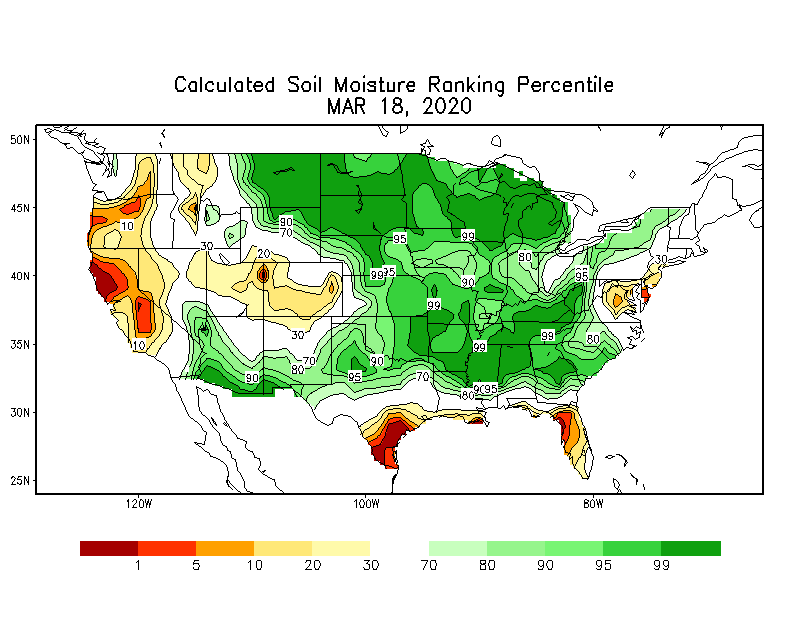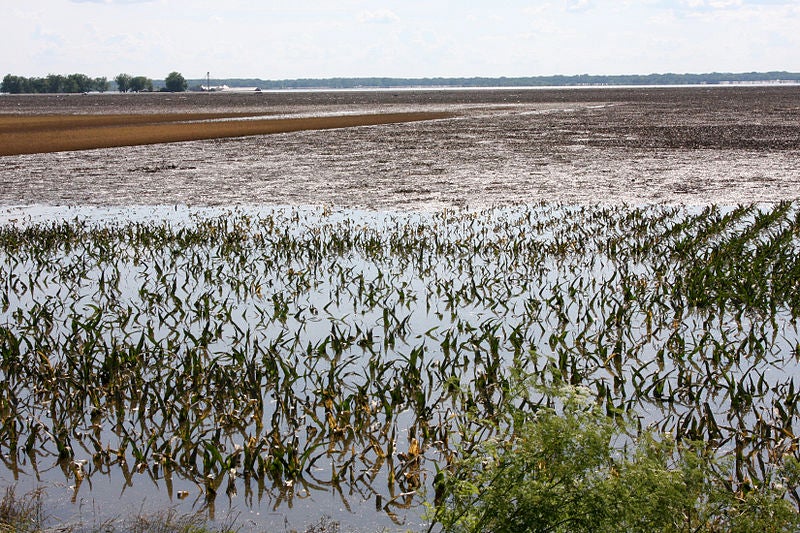Farmers have already been dealing with tough economic conditions exacerbated by a trade war, extreme weather and now the coronavirus. Unfortunately, the latest 2020 spring flood outlook shows that farmers in the Midwest could be facing yet another wet year.

Although projected to be less severe than 2019, the U.S. Spring Flood and Climate Outlook for 2020 predicts widespread flooding across 23 states with severe flooding in North Dakota, South Dakota and Minnesota. As a result of the 2019 floods, soils across the Midwest are full of moisture this spring, increasing the likelihood of flooding in 2020. Source: NOAA
Making American farmland resilient to growing weather shocks like flooding requires greater adoption of conservation practices such as no-till and cover cropping practices that improve water infiltration and reduce erosion and field runoff. Despite the financial benefits of these practices, adoption remains low across the country. In 2017, only 3.9% of U.S. farmland adopted cover crops.
How can we scale conservation practice adoption to reduce risk and boost resilience of the agricultural sector?
Policymakers and the farm financial system must mobilize to take actions that will substantially support farmers financially in adopting these essential conservation practices.
Here are three ways that ag lenders, crop insurers and policymakers can help producers make their farms more resilient to floods and extreme weather.
1. Incorporate the resilience benefits of cover crops in crop insurance
By improving soil health, cover crops help protect flooded land from erosion and can enable farmers to get back into their fields sooner.
As an important first step to incentivize cover crop adoption through federal crop insurance policy, Sens. John Thune (R-SD) and Debbie Stabenow (D-MI) recently introduced the Cover Crop Flexibility Act that would increase the flexibility of cover crop harvesting and grazing when flooding prevents farmers from planting their crops.
The bill also provides the groundwork for incorporating the risk reduction potential of cover cropping into federal crop insurance rates by directing the U.S. Department of Agriculture to conduct a study to analyze how cover crops reduce risks of prevented planting and other crop insurance losses. It also allows USDA to adjust rates or provide policies that integrate the risk reduction potential of cover crops in crop insurance premium calculations.
Reducing disincentives to cover crops after floods and incorporating the risk reduction benefits of cover crops to the widely used crop insurance program are two great steps to support adoption of cover crops and hopefully reduce losses. It’s not all bad news. Here are three steps that policymakers and business leaders can take to help farmers adjust to a new normal. Share on X
2. Collect and report data on performance of innovative programs
State policies and programs have always been important testing grounds for new ideas – especially for agriculture. In the case of crop insurance incentives for cover crops, Iowa and Illinois have introduced programs that provide a $5 per acre crop insurance rebate on cover crop fields not receiving cost share.
In its first two years, the Iowa program has enrolled 1,200 farmers and more than 300,000 acres, showing great interest in these kinds of incentives.
States across the country have the opportunity to test this and other proven effective incentive programs, and potentially make an effective case for similar federal programs. States could strengthen the case by measuring the yield variability impacts of conservation practices across weather conditions, with data to show federal policymakers and farmers what works.
3. Support resilient farming practices through agricultural lending policies and products
During the spring 2019 flooding, agricultural lenders projected operating loan default rates to increase by more than 10%. This risk compounded the challenges of low commodity prices that already stressed farmers’ budgets.
Under such circumstances, agricultural lenders may be tempted to discourage farmers from spending their limited funds on conservation expenses like cover crop seed. However, the resilience benefits of cover crops provide a strong argument to find a way to make them pencil out.

Flooding throughout the Midwest prevented farmers from planting on approximately 20 million acres in 2019, causing at least $1.6 billion of farm losses in Iowa alone. In total, flooding across the Missouri, Arkansas and Mississippi Rivers cost $20 billion.
Resources like last year’s guide, Cover Crop Economics: Opportunities to Improve Your Bottom Line in Row Crops, provide strategies for farmers to reap both financial and soil health benefits from cover crops. Lenders should familiarize themselves with such resources during challenging economic times.
Lenders can also identify opportunities to support farmers who adopt practices that build resilience through modified lending products. For example, banks could provide interest rate incentives or flexible payback periods to help farmers manage the initial transition and learning period associated with these practices.
As we head into another challenging year, these three steps are clear opportunities for policymakers and agriculture finance providers to reduce risk and boost resilience for American farmers.









